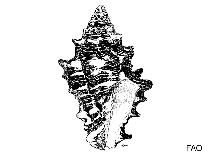Turbinella pyrum (Linnaeus, 1767)
Indian chank| Native range | All suitable habitat | Point map | Year 2050 |

|
| This map was computer-generated and has not yet been reviewed. |
| Turbinella pyrum AquaMaps Data sources: GBIF OBIS |
Upload your photos
Google image | No image available for this species;
drawing shows typical species in Turbinellidae.
Google image | No image available for this species;
drawing shows typical species in Turbinellidae.
Classification / Names Common names | Synonyms | CoL | ITIS | WoRMS
Gastropoda | Neogastropoda | Turbinellidae
Environment: milieu / climate zone / depth range / distribution range Ecology
Benthic; depth range 6 - 27 m (Ref. 106775). Tropical; 26°N - 5°N, 61°E - 83°E
Distribution Countries | FAO areas | Ecosystems | Occurrences | Introductions
Indian Ocean: Pakistan, India and Sri Lanka.
Length at first maturity / Size / Weight / Age
Maturity: Lm ?, range 12 - 14 cm
Found in shallow littoral zone (Ref. 106774). Gregarious. On sandy bottoms with mud and organic matter (Ref. 103878). Feeds on terebellid and eunicid polychaetes (Ref. 100729).
Life cycle and mating behavior Maturity | Reproduction | Spawning | Eggs | Fecundity | Larvae
This species is a non-broadcast spawner. Life cycle does not include trocophore stage.
Main reference
References | Coordinator | Collaborators
Panda, D., P. Jawahar and V.K. Venkataramani. 2011. (Ref. 103878)
IUCN Red List Status (Ref. 130435)
CITES status (Ref. 108899)
Not Evaluated
CMS (Ref. 116361)
Not Evaluated
Threat to humans
Harmless
Human uses
| FishSource |
Tools
More information
Internet sources
BHL | BOLD Systems | CISTI | DiscoverLife | FAO(Publication : search) | Fishipedia | GenBank (genome, nucleotide) | GloBI | Gomexsi | Google Books | Google Scholar | Google | PubMed | Tree of Life | Wikipedia (Go, Search) | Zoological Record
Estimates based on models
Preferred temperature
(Ref. 115969): 27.4 - 28.8, mean 28.5 (based on 128 cells).
Resilience
(Ref. 69278):
Medium, minimum population doubling time 1.4 - 4.4 years (K=0.27-0.33; tm=3).



